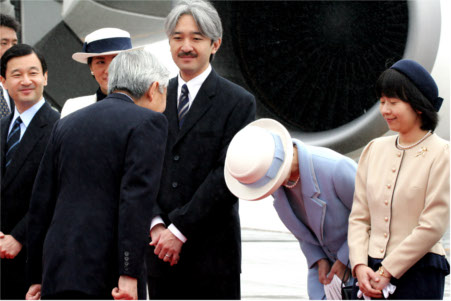
Emperor Akihito greets imperial family members (right to left) Crown Prince Naruhito, Crown Princess Masako, Prince Akishino, Princess Kiko and Princess Saya. Photo: Junko Kimura/Getty Images
by Toshio Aritake and OPC Past President William J. Holstein
Infectious disease czar Anthony Fauci has suggested that Americans and other Westerners might not want to risk shaking hands with each other once they begin to creep out of their coronavirus isolations and quarantines. What, then, will they do to greet each other?
Americans have heard suggestions that they should engage in elbow bumps and fist bumps, but those acts involve physical proximity and contact, however slight. The goal, it seems obvious, should be to avoid any contact while communicating warmth, respect and all the other positive signals that a firm handshake with full eye contact does. Air high-fives, while not physical, have a faintly ridiculous quality.
In the Muslim world, men place their right hand on their left chest when they say, salaam alaikum. (Peace be upon you.) Hindus in India place their hands together in front of their chests in a kind of church spire when they say namaste, which means “I bow to you” in Sanskrit.
But among all the world’s forms of greeting, perhaps the most worthy of study at the moment is the Japanese art of bowing called ojigi. The way the Japanese bow to each other can communicate a tremendous range of feelings. If I perceive that you have higher status than me, I bow more deeply to you than you bow to me. If I am particularly impressed to be in your presence, I would bow more slowly and hold the bow longer. The speed at which a bow is made, and how long it is held, communicate sincerity.
For apologies, the angle should be sharper than 30 degrees and for deep apologies, as steep as 45 degrees. When a politician or a corporate executive apologizes for misdeeds, they may bow 90 degrees — and hold it for about five seconds–with the hope of obtaining forgiveness.
There are also different bows in formal settings versus informal ones. When families gather for the annual spring equinox observances, for example, the elder males sit on tatami mats like Zen priests and bow to each other with a 15-30 degree inclination after saying things like “It’s been a long time since we’ve seen each other.”
But if you run into an old classmate you have not seen in years, the two of you would say things like “You haven’t changed a bit” and then exchange bows of only about 3 to 5 degrees. That informality implies friendship.
Japan has suffered periods of severe internal strife in its history and feudal military leaders have charted paths out of those periods by imposing codes of conduct on their samurai warriors, including bowing. The wider population emulated those practices. “Courtesy outweighs every other aspect of human relationships,” an old Japanese adage says. Japan also has a much higher population density than any Western country does, so bowing appears to have developed at least in part because it helps reduce the spread of diseases.
Japanese learn how to bow from their families but in some cases their knowledge has to be supplemented. Many companies offer bowing training to new employees because bowing in the business world is slightly different than in a family. There are even YouTube videos in Japanese aimed at teaching young people the art of bowing.
Westerners living or spending long periods of time in Japan often feel intense social pressure to bow to Japanese friends and associates and many have adopted Westernized versions of the bow, perhaps only a nod of the head. Bowing can become so second nature that a Westerner who returns to North America or Europe after a lengthy stay in Japan may find himself or herself bowing to people who have never bowed in their lives and regard the practice as slightly bizarre.
Americans in particular regard themselves as being equal to each other so it is unlikely that they will ever develop the art of bowing to the same degree that the status-conscious Japanese have. The Europeans will have a slightly different problem—overcoming their practice of multiple kisses upon meeting, which may involve as many as three kisses on alternate cheeks.
But all Westerners should know that bowing does not imply a loss of dignity or honor. A modest nod is not the same as the kowtowing that Chinese emperors once demanded or the full body prostration that Tibetan Buddhists perform when greeting a top religious leader. Learning how to express a range of feelings through bowing would represent a completely natural and wise way to respond to the coronavirus, which may linger and strike in different waves. Bowing, instead of shaking hands, could save lives.
The authors, friends for 40 years, collaborated on this article from Nagano Prefecture, Japan, and Westchester County, New York, where each is self-quarantining. Mr. Holstein is the author of the 1990 book, The Japanese Power Game: What It Means to America.
